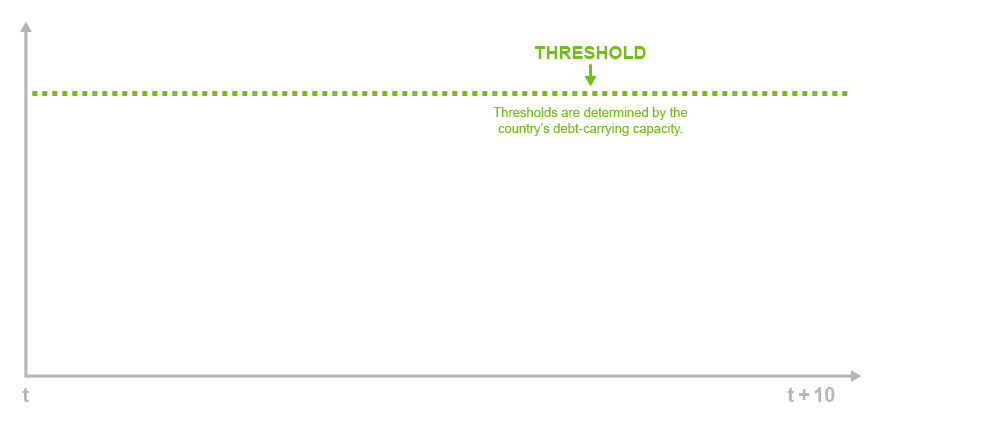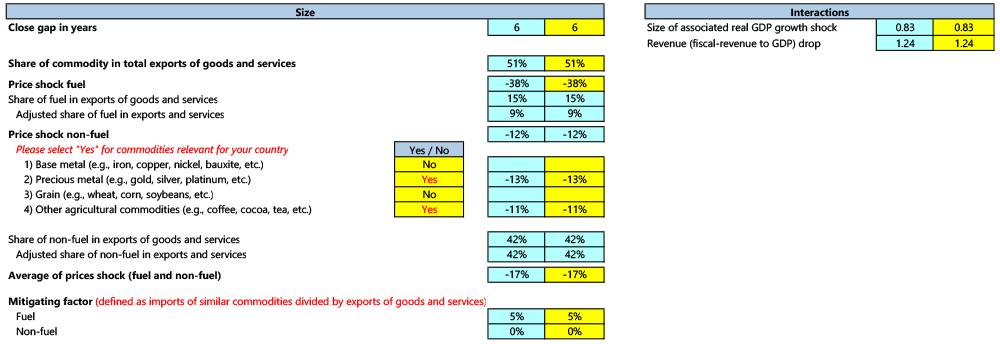
Stress Tests
In this station, we will discuss how to determine the sensitivity of projected debt burden indicators to changes in the assumptions. To assess this, the LIC DSF calculates the impact of temporary shocks on the evolution of debt burden indicators in both the external and public DSAs.
 |
Why does the DSF need stress scenarios? Substation 5.1 - Standardized Stress Tests Substation 5.2 - Tailored Stress Tests Substation 5.3 - Customized Stress Tests |
 |
Why does the DSF need stress scenarios?
- The baseline scenario should represent the most realistic macroeconomic and debt portfolio assumptions based on the most current and best available knowledge.
- However, future realizations may differ from baseline projections due to the uncertainty surrounding the baseline scenario.
- One way to gauge the impact of such uncertainty is through the use of stress scenarios.
Stress Tests and Risk Rating

Recall: Risk ratings are based on several debt ratios breaching their respective thresholds. Breaches of thresholds under stress tests indicate debt vulnerabilities to shocks and affect a country's risk rating.
The most extreme stress test informs the calculation of the mechanical risk signal (defined as the test that yields the highest level of debt on or before the tenth year of projection, which has a greatest chance to breach the threshold among stress tests). In addition, where the test, rather than the baseline, leads to a breach of any of the thresholds, the mechanical risk signal switches from “low” to “moderate".
Stress Tests in the LIC DSF
The LIC DSF template automatically applies stress tests to gauge the sensitivity of the projected debt burden indicators to changes in the underlying assumptions. It calculates the impact of temporary shocks on the evolution of debt burden indicators in both the external and public DSAs.
Types of Stress Tests
-
Standardized Stress Tests
-
Tailored Stress Tests
-
Fully Customized Stress Tests

Standardized Stress Tests
Standardized Stress Tests are universally applied to both public and external DSAs in all LIC DSF countries. They consist of the historical scenario, as well as various scenarios with temporary shocks to real growth, primary balance, exports, other flows (current transfers, foreign direct investment), and domestic currency depreciation. Click on each shock for more details.
Shock Scenarios
Shock Design
The DSF standardized stress tests apply temporary shocks to a set of macroeconomic variables. The magnitude of these shocks is based on the historical behavior of these variables in each country. Specifically, most stress test shocks set the relevant variable (GDP growth, export growth, primary balance, and current transfers and FDI flows) at one standard deviation below its historical average for two consecutive years. Both the averages and the standard deviations are calculated using each country’s historical annual data over the most recent ten-year period. The exchange rate shock is the exception, which is defined as a one-off 30 percent nominal depreciation, or the size needed to close the estimated real exchange rate overvaluation gap, (on top of the baseline projections) of the domestic currency for all countries regardless of their historical exchange rate movements.
However, to address possible bias from historical averages, there is an alternative approach to derive post-shock values from baseline projections. The baseline projections turned out to have better predictive power for future performance than historical averages, having smaller median forecast errors as well as smaller standard deviations in forecast errors. However, basing the shock scenario solely on baseline projections may have shortcomings. In particular, it would not work as envisaged when baseline projections are too optimistic. An effective approach is to set post-shock values at one standard deviation below the historical average, or the projected value under the baseline, whichever is lower, so to minimize possible biases from historical averages, while at the same time limiting the potential bias from overly optimistic baseline projections.
An event analysis was also conducted to evaluate the appropriateness of the assumed duration of shocks. Using the WEO database, the study compares the shocks used in the current DSF with the distribution of outturns over the 1995-2015 period to assess whether the duration of stress test shocks was adequate. Specifically, the study first identified “events” where an outturn has fallen below a shock as used in the existing DSF (i.e., 10-year historical average minus one standard deviation). Results indicate that a shock duration of about 2 years remains broadly appropriate.
If you would like to find more information check out the DSF Policy Paper
Shock Interactions Among Variables
Interactions of key macro variables under the standardized stress tests were identified using event studies and complemented with the literature. The event study analyzed the behavior of key variables – including FX nominal depreciation, real GDP growth, GDP deflator, and export growth – under the relevant economic shocks. To remove the impact of outliers and appropriately capture the characteristics of the interactions, events are defined as cases where an outturn falls near the relevant cutoff for shocks (i.e. its historical average minus one standard deviation). For example, events for the growth shock are defined as those where actual GDP growth falls between a historical average of minus 1.25 and 0.75 standard deviations. Based on this sample of events, elasticities were calculated. These calculations suggest that inflation decreases with an elasticity to real growth of 0.6 and real GDP growth falls with an elasticity to exports of 0.8. Exchange rate pass-through to the GDP deflator is estimated at 0.3 in the year of the shock (Table AI.5). Other interactions are taken from the literature (e.g. Aisen and Hauner (2008) on the domestic borrowing costs-primary balance interaction).

If you would like to find more information check out the DSF Policy Paper
Shock Interactions Among Variables for Primary Balance
Bias in historical averages appears to be the main driver for the underestimated primary balance shock. As post-shock values in DSA stress tests are set at one standard deviation below historical averages, a key assumption is that the 10-year historical averages and standard deviations are good predictors for the performance of the relevant indicators in the projection years. This assumption did not hold for the primary balance: outturns of primary balances turned out to be lower than historical averages in about 2/3 of all the observations (Table AI.2). On average, the actual primary balance to GDP ratio was 1.2 percentage points lower than historical averages.

To correct for the possible bias from historical averages, an alternative approach would be to derive post-shock values from baseline projections. The baseline projections turned out to have better predictive power for future performance than historical averages, having smaller median forecast errors as well as smaller standard deviations in forecast errors (Table AI.3). However, basing the shock scenario solely on baseline projections may have shortcomings. In particular, it would not work as envisaged when baseline projections are too optimistic. An effective approach would be to set post-shock values at one standard deviation below the historical average, or the projected value under the baseline, whichever is lower, so to minimize possible biases from historical averages, while at the same time limiting the potential bias from overly optimistic baseline projections. Indeed, calculations using the same sample show that once this approach is applied, the post-shock value of primary balance would be at about the 16th percentile of the distribution of actual outturn, in line with other shocks.

If you would like to find more information check out the DSF Policy Paper
Shock Design
The following macroeconomic variables are set to their respective 10-year historical averages: real GDP growth, primary balance-to-GDP ratio, GDP deflator, non-interest current account, and net FDI flows. This scenario is used as a realism check for the baseline scenario and does not inform mechanical risk signals.
Shock Design 
In the second and third projection periods, real GDP growth set to its historical average minus one standard deviation, or the baseline projection minus one standard deviation, whichever is lower.
Shock Interactions among Variables 
- Inflation decreases with assumed elasticity to growth equal to 0.6.
- Primary balance deteriorates due to the revenue-to-GDP ratio remaining the same as under the baseline, while the ratio of non-interest expenditures-to-GDP increases to maintain the baseline level of spending.
Shock Design 
In the second and third projection periods, primary balance-to-GDP ratio set to its historical average minus one standard deviation, or the baseline projection minus one standard deviation, whichever is lower.
Shock Interactions among Variables 
- For a LIC with domestic market financing, domestic borrowing costs rise by 25 basis points for each 1 percent of GDP in primary balance deterioration.
- For market-access LICs, external commercial borrowing costs increase by 100 basis points for each 1 percent of GDP in primary balance deterioration, or by 400 basis points, whichever is lower.
Shock Design
Apply all individual shocks above(except for the Historical Scenario) at half of each shock magnitude.
Shock Interactions among Variables
- All the interactions from each individual shock scenarios.
 Key Messages
Key Messages
- The LIC DSF template automatically applies the historical scenario and the following standardized stress test scenarios to both external and public DSAs: the real GDP growth shock, the depreciation shock, and a combination of all shocks scenario. In addition, the public DSA includes the primary balance shock and the external DSA features export and other flows shock scenarios.
- The historical scenario sets the key drivers of debt dynamics for external and public debt to their respective historical averages (over the last 10 years). This is used for a realism check and does not inform mechanical risk signals.
- The sizes of the other standardized shocks (except for the depreciation shock) are set to the historical average minus one standard deviation or the baseline projection minus one standard deviation, whichever is lower.

Tailored Stress Tests
Tailored Stress Tests are related to so-called “tail” risks. They only apply to a country if relevant and likely, and they have implications for a country's risk rating. The exception is the Contingent Liabilities stress test, which applies to all countries.
1. Contingent Liabilities
2. Natural Disasters
3. Volatility of Commodity Exports
4. Market-Financing Shocks
For each tailored stress scenario, default parameters of the stress scenario are based on cross-country averages but are expected to be customized based on country-specific characteristics.
Contingent Liability Stress Test
The Contingent Liability (CL) Stress Test applies to all countries.
The Contingent Liabilities Tailored Stress Test is built to take into account elements of the broader public sector that were missing from the debt definition in the DSA.
The shock has a minimum starting value and a tailored value, depending on the vulnerabilities outside the public sector that are already covered by the DSA.
| Shock Trigger | Shock Size and Interactions |
|---|---|
| Financial sector (applicable to all) | One-off shock of 5 percent of GDP + tailored element (user specified) |
| Incomplete coverage of the general government | Shock as defined by user (based on country history, and missing elements of general government) |
| PPP capital stock above 3 percent of GDP | Debt increases by 35 percent of PPP capital stock in second year of projection |
| Unaccounted or partially accounted SOEs' guaranteed external debt that has not been accounted for in the general government | 2 percent of GDP increase in public debt from second year of projection |
Contingent Liability Shock
Users can customize the contingent liability shock by filling in the following table in the template:
 Exercise: Determine the size of the contingent liability shock in the tailored stress test. Modify the assumptions below
Exercise: Determine the size of the contingent liability shock in the tailored stress test. Modify the assumptions below to see the overall size of the CL stress test.
The default shock of 2 percent of GDP will be triggered for countries whose government-guaranteed debt is not fully captured under the country's public debt definition. If it is already included in the government debt, and risks associated with SOE debt not guaranteed by the government are assessed to be negligible, it may be reduced to 0 percent.
 Considerations
Considerations
- Are there known additional contingent risks in the financial sector? For example, those identified in an asset quality review?
- Do the missing elements of general government have the potential to generate debt vulnerabilities? For example, do budgetary funds have a history of government bailouts?
- Does a specific SOE pose a risk to debt sustainability? Can it cover its gross financing needs over the next several years?
- Is the PPP capital stock larger than assumed? How risky is the PPP to the government? Are the likely costs greater than 35 percent of the nominal value? PPPs are typically related to infrastructure, but they could also be projects in other sectors of the economy, such as in the healthcare system.
- Also consider any other shock relevant to your country, such as those based on specific historical circumstances or potential missing elements of the general government.
Natural Disasters
| Shock Trigger | Shock Size and Interactions |
|---|---|
| Small states vulnerable to natural disasters | One-off shock to public debt of 10 percent of GDP in the second year of projection |
| Countries that meet the frequency (2 disasters every 3 years) and economic loss (greater than 5 percent of GDP/year) criteria | Real GDP growth lowered by 1.5 percentage points in the year of the shock |
| Exports are lowered by 3.5 percentage points in the year of the shock |
In the template, this table is in the “Input 6 – Tailored Tests” sheet.

 Considerations
Considerations
- Does the baseline macro framework already assume an average impact from natural disasters? Ensure that double-counting is avoided.
- Do you have empirical evidence that the size of the shock should differ from the default setting of 10 percent of GDP? Would that impact the ability to cover your gross financing needs over the next several years?
- Do you have empirical evidence that the default setting of export and GDP growth interactions should be changed?
Volatility of Commodity Exports
Commodity Exports Interactions
Interactions for real GDP growth and fiscal revenue-to-GDP are applicable in the first three years of the shock for each 10-percentage point contraction of commodity prices, converging to the baseline in 6 years.
In the template, this table is in “Input 6 – Tailored Tests” sheet.

 Considerations
Considerations
This test can be adapted to take into account a contemporaneous fall in the price of a key import and can be netted out for the purposes of the shock as a “mitigating factor” in the template. For example, exporting crude oil and importing refined oil.
- Is there a reason to model a bigger/smaller shock to commodity prices?
- What is the historical evidence of the commodity/country/region during the commodity cycle? Is it different from the default setting?
- Do you have empirical evidence that the default setting of export and GDP growth interactions should be changed?
External Market Financing Shock
For countries with market access, this scenario helps focus discussions on potential market stresses during upcoming rollovers.
| Shock Trigger | Shock Size and Interactions |
|---|---|
| Countries with at least one of the following: | A combination shock, which includes: |
| Have outstanding Eurobonds, and/or have access to the international financial markets on a durable and substantial basis | An increase in borrowing costs of market-based financing of 400 bps (sustained for 3 years) and shortening to 5-year maturity or shortening by 2/3 of the original maturity that is less than 5 years for newly issued market debt; and |
| One-off nominal depreciation equivalent to 15 percent | |
In the template, this table is in the “Input 6 – Tailored Tests” sheet.

 Considerations
Considerations
- Is there empirical country-specific evidence suggesting the response to a market financing shock in borrowing costs/depreciation/maturity shortening may be different?
 Key Messages
Key Messages
- The size of the contingent liability shock must be customized depending on the coverage of public debt.
- This requires information about the size of potential contingent liabilities that may arise from Public-Private Partnerships (PPPs), the financial sector, explicit government guarantees, and other public sector obligations which are not included under the baseline scenario.
- Customization of shock parameters for other tailored stress tests should be based on your country's characteristics.
- Some stress tests will require more information to correctly calibrate shocks, such as commodity export composition to help inform the commodities shock.

Customized Stress Tests
In addition, fully-customized stress test scenarios are relevant for specific risks not covered by the template.
Fully-Customized Scenarios
Examples include, but are not limited to, the following scenarios:
- Idiosyncratic risks, such as an epidemic;
- Large delays in investment projects; and
- Policy slippage where different outcomes lead to very different debt paths.
Customized scenarios can also be used to investigate alternative financing strategies and their implications without affecting the risk rating, such as a scenario for achieving sustainable development goals, a debt restructuring scenario, or a higher grant scenario.
While fully flexible in their design, customized scenarios inform the risk ratings in the same way that other stress tests do.
There are two options of incorporating customized stress tests into the LIC DSF:
1. Use the “Customized Scenario” sheets in the template to design a stress test.
2. Create an alternative baseline and enter them in separate template from the original baseline.
 Takeaways for Station 5
Takeaways for Station 5
- Stress test scenarios are critical for understanding the nature of risks to which a LIC is vulnerable and to inform the risk rating.
- Tailored stress tests help provide insights on specific risks relevant for some LICs.











